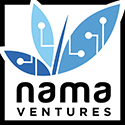This post is about sharing with the entrepreneurial community what Nama Ventures looks for when reviewing an investment pitch by a startup. Now every fund has their own way of evaluating a pitch, no fund is created equal, specially that funds differ greatly in their investment stage and thesis.
We happen to be a pre-seed fund, a first money in fund, so naturally we will seek to weigh our analysis more on teams that market traction for example, actually most of our investments are in startups that are pre-revenue, so they basically have no market traction, so you see how each fund might look at a matter from a different angel.
We think that you can really capture any startup in the pre-seed stage in 9 slides. Below we’ll go over them one by one. Again, I want to emphasize that there are is no right or wrong answer, we just want to highlight to entrepreneurs what the information below really captures the essence of startup in preseed, we have seen thousands of pitches ( I’ve been investing since 2005) and some seem to capture the attention of the investor more than others.
Now to the slides:
1- Describe the problem / the pain you are trying to solve.
As far as Nama is concerned, your startup starts with a problem you want to solve, what is that one thing, notice the word one, that drove you to pursue the entrepreneurial path. Now there is no right answer here, but for Nama, we like the problem to be a painful one, a problem worth solving. This slide should be simple, try to visualize your problem in a sentence. Simplicity is king
Also make sure you answer the Why question in your description of the pain, Why are you doing this startup ? and when you are pitching in front of a live audience, tell the Why answer in an engaging format, give your Why a purpose.
2- Describe the solution you’re offering via describing your product / service.
Now that you really captured the problem in your first slide, the solution slide allows you to describe your solution to that problem by describing your product or service you are building. Again, simplicity is key, one problem should have one solution, and always address it from your customer’s perspective, walk us through the solution through the eyes of your customer.
3-Team
If you ask anyone at Nama what do we invest in, they will tell you within one second we invest in teams. At the pre-seed stage, that’s basically all what we have to go by, a team that has decided to go after a problem with a solution, so we need to see how this team, notice the word team, will be the right team to tackle this problem, rest assured there are many teams going after this problem, we want to bet on the best team.
Highlight to us in this slide how is this team is the right one, what complementary skills do they have, is there a “seller” in the team and a “doer” ( a technical co-founder ) etc..
Now the team in Nama’s eyes is made up of multiple founders, so you need to share with us the Capitalization Table of the startup to make sure the founding team is equity incentive to keep solving the problem they identified because if they solve it they all will be greatly rewarded.
Now any smart founding team would have armed themselves with great advisors, people that will fill / complement any knowledge gaps the founding team has to solve the identified solution and scale the solution to a large enterprise. Remember that any founding team’s dream is to graduate from being a pre-seed startup to an eventual publicly listed company.
Another important factor to consider in the team, and it’s not very typical in pre-seed but some more mature startups have a strong founding team and also a strong next layer of equity incentivised hires ( usually with an Employee Stock Option Plan (ESOP) ) that are working hard for the success in that startup, if they are good, and they better be, then we need to know about them and their skill sets.
4- The market
Markets are the sea that startups sail in, the larger these markets, the better the riches startups can discover sailing in them. As a matter of fact, some funds, more famously Sequoia, puts markets before the team, so the market slide needs to demonstrate how large your market is, is it a growing market? at what growth rate? What are your market metrics? what is your Total Addressable Market ( TAM ), your Serviceable Addressable Market ( SAM ) and you Serviceable Obtainable Market ( SOM ). there is plenty of content on the internet regarding TAMs, SAMs and SOMs and market growth rates for you to research, even if you are deriving these numbers, put in significant thought into how you derived them, if you are referencing them from resources, make sure these resources are credible and list them.
Here is where you can give us a glimpse of the customer and what personas you are targeting, to capture customers in your target market.
5- Competition
If you want to lose us at Nama Ventures when we are evaluating your pitch deck, just say that you don’t have competition, we’ll stop and move on. In our view, competition validates markets, even better, global competitors tell us there is a path to liquidity by having an exit for your startup. When it comes to competition, the more the merrier in our eyes.
They say if you have a good idea 5 people have already thought about it, but if you have an amazing idea, 15 people of already thought about it, trust me you do have competitors, you might not know about them but they do exist, we’ve met founders that are so in tune with their competitive landscape that they know startups in their space that are in stealth mode !
Now we do have a favorite way of representing your competition. Imagine a excel sheet, where the columns lists you and your competitors, start with your startup as the first column, then list your local competitors by name, your regional competitors , and lastly list your global competitors. In the rows you will demonstrator to us how you are better than them, your competitive advantage, and of course in your startup’s column all the rows have a check marker in them. This format has the advantage of hitting two birds with one stone, it addresses who are your competitors, and tells us your competitive advantage over them.
6- Business model
A startup is a business, and each business has a business model, how it it generate revenues?, what are its revenue streams?, what is its pricing structure? sources of sales? distribution channels of selling their product or service? etc… some businesses have key business model metrics that you need to highlight, for example in Software As A Service (SAAS) business, you want to know your CAC, LTC ( something there are assumed or derived from experience) your unit economics, etc…
Basically how are you going to make money?
Sometimes your business model is not about generating money initially, let’s assume you have an initial strategy of URL ( ubiquity first, revenue later ), in other words, you initially want to gather users for free. Then show us how will you be able to do so.
7- Financials (Profit and Loss statement )
Remember that this slide is not your full financials, in the due diligence phase all the numbers will be pulled out. This slide is in your investment pitch deck, in this slide, we want to see the high level model of your 6 to 12 month P & L, what are your assumptions on revenue, costs, hiring. etc.. We want to get a comfort level that you have been able to model your business. No founding team can manage their startup without an effective model of their business where they can model and constantly adjust their model of how they will win , generate more revenue, enjoy better margins, reduce costs as they scale etc..
Show us that you are capable of visualizing your startup in a high level excel sheet.
8 – The future
At Nama, as we said in slide 1 & 2, we like to see at pre-seed one problem being addressed by one solution, but does not mean that a founding team should not have a vision and dreams, so in this slide need to give us a glimpse of the end result, don’t worry, we know that in the journey you gain insight, and that there will be pivots along the way, but if you had a magic wand, waive it to show us where your end vision, what new markets, products, spaces you want to go after.
9- The Ask
Answer these three simple questions in the last slide. What are you looking to raise? What are you going to do with the money? And what are you willing to give for it ?
This is very crucial, at Nama , we are of the school of thought that if you don’t know how much you need, and what you are going to do with that money ( which should be answered in the financial model slide ) and are you willing to give as an equity % of your startup for it, then you are not ready for funding, you have to have these three questions answered before knocking on investors doors, even if you are raising convertible notes, have an understanding of the the Cap on that note ( if you are raising a note with no cap please don’t apply to Nama Ventures 🙂
Our advice here is don’t give ranges, it shows you don’t have a clear model for your business, don’t ask for $X to $Y, a startup needing $X looks different than a startup that needs $Y to succeed. Be surgical with your answer, trust me , investors will negotiate with you, have a clear understanding of the valuation footing you are standing on. Plus sometimes your valuation is too “rich” for us, you are in a different league than what Nama Ventures plays in, so we might tell you we are the wrong fund to approach, so having a clear answer on this slide saves everyone a lot of time. Sometimes you have one shot at leaving a good impression on investors, make sure you take the best shot.
In conclusion, you can do wonders with 9 slides, at Nama, that’s all that we need.
And I want to reiterate again, this post is about what Nama Ventures looks for in an investor pitch, there is no right or wrong pitch deck, and not all funds are the same, this is an attempt to give you a guide to what pre-seed / seeds funds like Nama Ventures look for.
And we wish you nothing but the best in your entrepreneurial journey 🙂
Mohammed.



